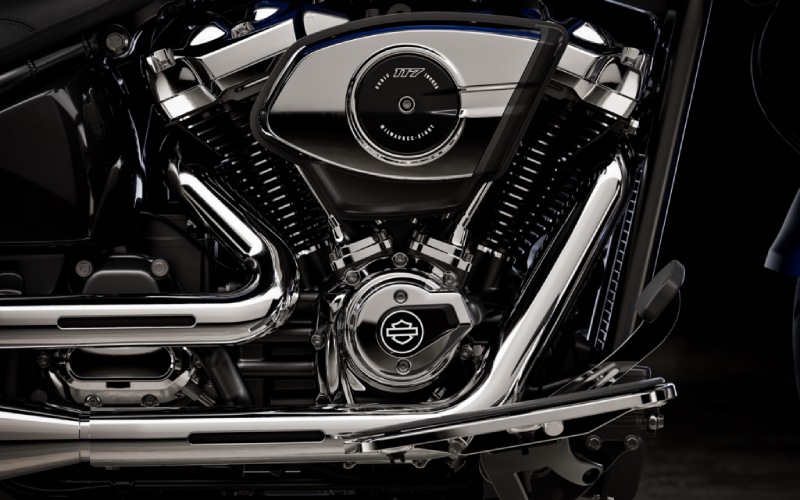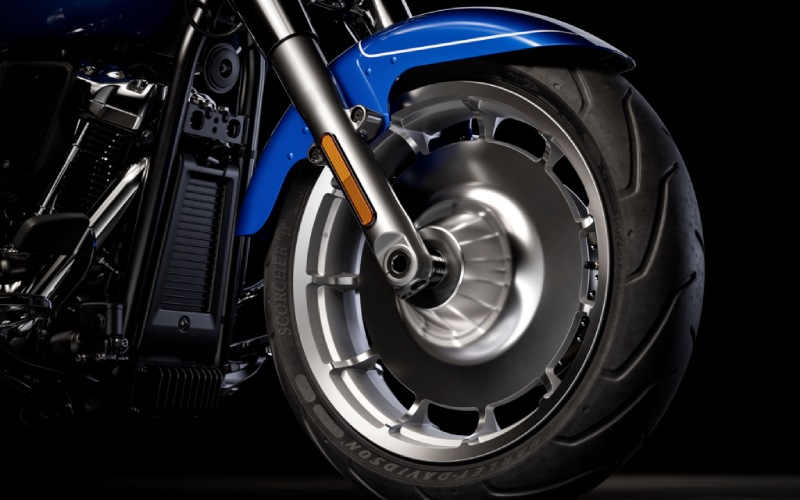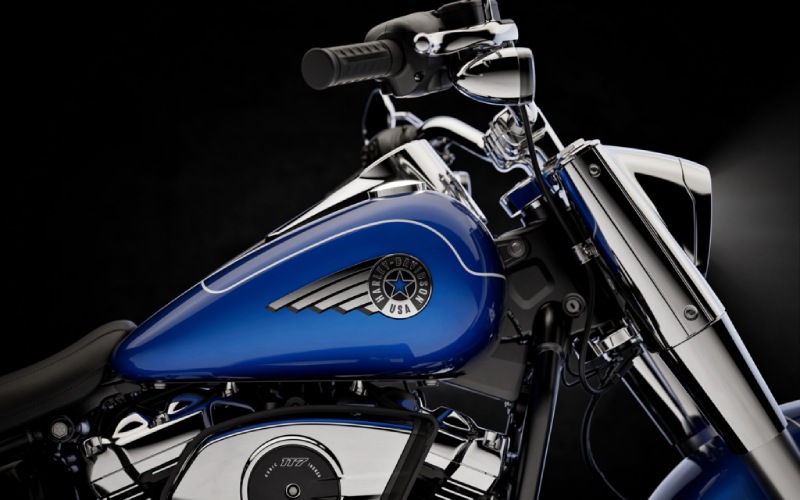2025 Harley-Davidson® Fat Boy® vs 2025 Harley-Davidson® Low Rider® S near Cincinnati, OH
2025 Harley-Davidson® Fat Boy® vs 2025 Harley-Davidson® Low Rider® S
The matchup of 2025 Harley-Davidson® Fat Boy® vs 2025 Harley-Davidson® Low Rider® S puts two icons of the Cruiser lineup in sharp relief: one a legend of muscular style and confident road presence, the other a West Coast performance benchmark tuned for attack. Both arrive with Milwaukee-Eight 117 power, modern Ride Modes, Traction Control, USB-C charging, and refined hand controls, yet they celebrate different personalities. The Fat Boy® leans into chrome, 18-inch Lakester wheels, a polished headlight nacelle, and updated monoshock comfort, while the Low Rider® S strips down with blacked-out finishes, a steep-backed solo seat, LED lighting, and a tall monoshock that boosts cornering clearance. At Queen City Harley-Davidson® near Cincinnati, OH, we appreciate how these machines deliver distinct experiences without compromising authenticity. Riders who want an imposing, long-mile cruiser with a rich two-into-two soundtrack will gravitate to the Fat Boy®, while those who crave precision responses, rapid transitions, and a high-rev character will feel at home on the Low Rider® S. For enthusiasts near Cincinnati, OH, the choice comes down to which kind of grin you’re chasing and how you prefer to carve your daily miles.
| Feature | 2025 Harley-Davidson® Fat Boy® | 2025 Harley-Davidson® Low Rider® S |
|---|---|---|
| Milwaukee-Eight 117 V-Twin | Yes | Yes |
| Heavy Breather Intake | No | Yes |
| Two-into-One Exhaust | No | Yes |
| Two-into-Two Exhaust | Yes | No |
| Ride Modes | Yes | Yes |
| Traction Control | Yes | Yes |
| Cruise Control | Yes | Yes |
| USB-C Charging | Yes | Yes |
| Adjustable Brake Lever | Yes | Yes |
| Tall Rear Monoshock for Increased Cornering Clearance | No | Yes |

Key Features
When evaluating 2025 Harley-Davidson® Fat Boy® vs 2025 Harley-Davidson® Low Rider® S, the signature touches stand out immediately. The Fat Boy® showcases 18-inch machined Lakester wheels wrapped in massive rubber for a commanding stance, cutback fenders that frame the tire profile, and an iconic polished chrome headlight nacelle that shouts heritage. Its updated monoshock suspension targets comfort while staying composed in brisk riding, and the new high-flowing two-into-two exhaust preserves the model’s unmistakable silhouette and sound. A five-inch analog gauge with integrated digital info brings modern convenience, including Ride Modes, Traction Control, Cruise Control, and a USB-C port to keep devices powered. By contrast, the Low Rider® S arrives murdered-out with subtle red accents, a sleek two-into-one exhaust, and a Heavy Breather intake angled into the wind for aggressive style and performance. A steep-backed solo seat braces hard launches, while the tall rear monoshock fires up extra cornering clearance for riders who push limits. The riser-mounted four-inch analog gauge includes a digital window for Ride Modes and Safety Enhancements, and full LED lighting adds a crisp, modern glow. At Queen City Harley-Davidson® near Cincinnati, OH, we see both bikes as thoroughly modern machines that respect tradition: the Fat Boy® leans toward bold cruiser aesthetics and plush composure, while the Low Rider® S channels focused performance and razor-sharp feedback.

Dimensions
Dimensionally, the Fat Boy® projects width and presence. Those 18-inch Lakester wheels, combined with massive tires and cutback fenders, visually lower the machine and ground it with an unmistakable stance. The rider triangle favors an easygoing, open posture that pairs well with long-mile comfort and steady urban cruising. The Low Rider® S, meanwhile, sits tighter and taller at the rear thanks to its elevated monoshock, which subtly rotates rider weight forward into a more assertive posture. The steep-backed solo seat adds support under acceleration, and the riser-mounted gauge positions key info in your line of sight. Both frames deliver low seat heights typical of this class, but the Low Rider® S feels narrower and more compact between the knees, aiding confidence in quick maneuvers. These thoughtful proportions underscore the split: the Fat Boy® celebrates muscular width and visual drama; the Low Rider® S emphasizes purposeful compactness and road-focused ergonomics.

Engine
Both motorcycles draw from the Milwaukee-Eight 117 family while expressing unique characters. The Fat Boy® features the Milwaukee-Eight 117 Custom engine, tuned for effortless highway cruising and satisfying in-town punch. Its new, high-flowing two-into-two exhaust complements the V-twin’s deep cadence and throttle response, while updated rear suspension aids smooth power application over varied pavement. The Low Rider® S carries the Milwaukee-Eight 117 H.O. engine, tuned to deliver peak power higher in the rev range. Paired with the Heavy Breather intake and a light, compact two-into-one exhaust, it responds with immediacy and rewards riders who like to carry gears longer before shifting. Both engines pair with Ride Modes that adjust throttle mapping and electronic intervention to match conditions, and both use Traction Control to help optimize grip when surface traction changes. The result is an unmistakable V-twin pulse tailored to two distinct riding styles.
Performance
Performance tuning separates these siblings. The Fat Boy® aims at broad, confident capability—its suspension update improves comfort without losing its planted, composed feel in spirited runs. The big footprint of the Lakester wheels and massive tires adds a sense of stability on straightaways and sweeping corners, and the two-into-two exhaust preserves the classic cruiser rhythm riders expect. The Low Rider® S tilts toward speed and precision. A tall rear monoshock raises the back end for added cornering clearance, encouraging aggressive lean angles, and the Heavy Breather plus two-into-one exhaust reduces mass and sharpens throttle transitions. Braking hardware and chassis tuning are oriented toward riders who load the front end under hard decel and then flick quickly from one apex to the next. Choosing between the two becomes an honest conversation about how you like to ride—relaxed and authoritative, or assertive and surgically precise.
Drive Train
Each bike’s driveline character reflects its mission. On the Fat Boy®, the Milwaukee-Eight 117 Custom is mapped for abundant torque at practical road speeds, easing roll-on passes and highway merges with relaxed effort. The two-into-two exhaust breathes freely while maintaining a balanced feel that complements the chassis’ measured, confident responses. On the Low Rider® S, the Milwaukee-Eight 117 H.O. spins with an eagerness that invites later upshifts and deeper braking zones; the two-into-one exhaust helps concentrate mass and promotes scavenging at higher revs. Both motorcycles integrate Ride Modes that tailor throttle delivery and electronic intervention to the moment—whether you want smoother response in traffic or maximum feedback on a clear back road. In everyday use, the drivetrains align with their personalities: the Fat Boy® rewards relaxed torque surfing; the Low Rider® S begs to be worked.
Performance
Performance tuning separates these siblings. The Fat Boy® aims at broad, confident capability—its suspension update improves comfort without losing its planted, composed feel in spirited runs. The big footprint of the Lakester wheels and massive tires adds a sense of stability on straightaways and sweeping corners, and the two-into-two exhaust preserves the classic cruiser rhythm riders expect. The Low Rider® S tilts toward speed and precision. A tall rear monoshock raises the back end for added cornering clearance, encouraging aggressive lean angles, and the Heavy Breather plus two-into-one exhaust reduces mass and sharpens throttle transitions. Braking hardware and chassis tuning are oriented toward riders who load the front end under hard decel and then flick quickly from one apex to the next. Choosing between the two becomes an honest conversation about how you like to ride—relaxed and authoritative, or assertive and surgically precise.
Chassis
The chassis DNA diverges in clear, rider-facing ways. The Fat Boy® frames its updated monoshock in service of comfort and confidence, supported by a stout front end that visually amplifies the polished chrome nacelle. It rides big yet remains manageable, soaking up imperfect pavement and tracing smooth arcs with minimal drama. The Low Rider® S goes the other direction: its tall monoshock pitches the stance into a performance envelope, enabling faster direction changes and extra lean clearance. The steep-backed solo seat gives you a locked-in perch, and the blacked-out finishes reduce visual bulk so the bike looks as agile as it feels. Both retain the rigid-mounted Milwaukee-Eight refinement and a responsive front end, but the Low Rider® S tunes feedback for riders who deliberately seek technical roads, while the Fat Boy® cruises with unmistakable presence through the city and across state lines.
Electric
Modern tech quietly elevates both bikes without stealing the spotlight. The Fat Boy® uses a five-inch analog gauge with an integrated digital display, surfacing Ride Modes and key ride data at a glance. USB-C charging sits within easy reach to power navigation or communications through a Bluetooth headset, while updated hand controls make it simple to engage functions like Cruise Control and Traction Control. The Low Rider® S mirrors that approach with a riser-mounted four-inch analog gauge plus digital info, LED lighting front and rear, and USB-C charging for all-day device support. Both motorcycles keep screens minimal and information essential—clean, legible, and rider-first. The result is a purposeful interface: just enough technology to amplify your control and comfort without diluting the visceral connection that defines a proper Cruiser.
Rider Safety Enhancements
Confidence tech is a shared pillar for these models. Each brings a suite of Rider Safety Enhancements that includes Ride Modes, Traction Control, and Cruise Control, with braking systems designed to deliver predictable stopping power and characteristics suited to their intended use. The Low Rider® S calls out its full suite more explicitly, pairing it with updated ergonomic hand controls and an adjustable brake lever so riders can dial in feel. The Fat Boy® similarly updates its controls and adds an adjustable brake lever to harmonize reach and feedback. USB-C charging extends device uptime for navigation and communications, supporting riders who cover serious distance. While these systems operate in the background, their effect is clear: more consistency when conditions change and less fatigue across a wide range of riding scenarios—whether you’re carving a favorite road or crossing town near Cincinnati, OH during rush hour.
Request more 2025 Harley-Davidson® Fat Boy® vs 2025 Harley-Davidson® Low Rider® S near Cincinnati, OH information
Choosing between the 2025 Harley-Davidson® Fat Boy® vs 2025 Harley-Davidson® Low Rider® S is less about better or worse and more about which flavor of excellence fits your style. The Fat Boy® doubles down on iconic presence with chrome details, Lakester wheels, and a plush, updated ride that remains composed when you pour it on. The Low Rider® S courts riders who live for the upper revs, bigger lean angles, and a blacked-out aesthetic that telegraphs performance from any distance. Both serve as compelling daily companions near Cincinnati, OH, and beyond, delivering modern tech, confident safety features, and that unmistakable Milwaukee-Eight soundtrack. Our team at Queen City Harley-Davidson® is here to help you explore both paths, whether your daily miles cut across neighborhoods in Mason and Batavia or your weekends take you to the open roads near Cincinnati, OH. Either way, the right answer is the one that keeps you riding more often with a bigger smile.


